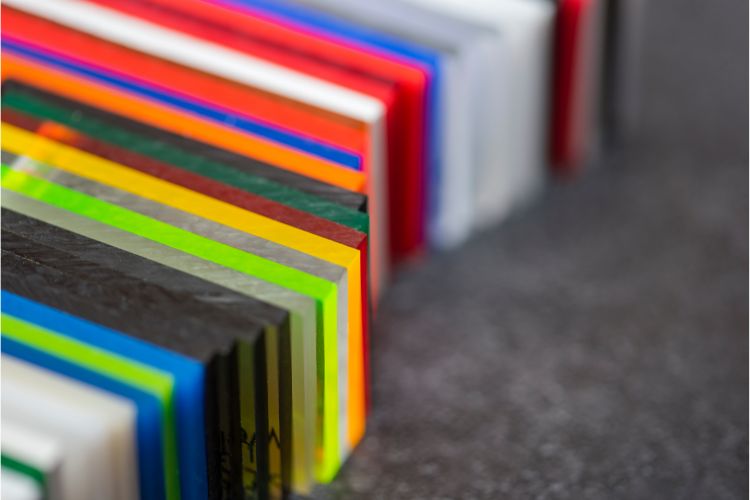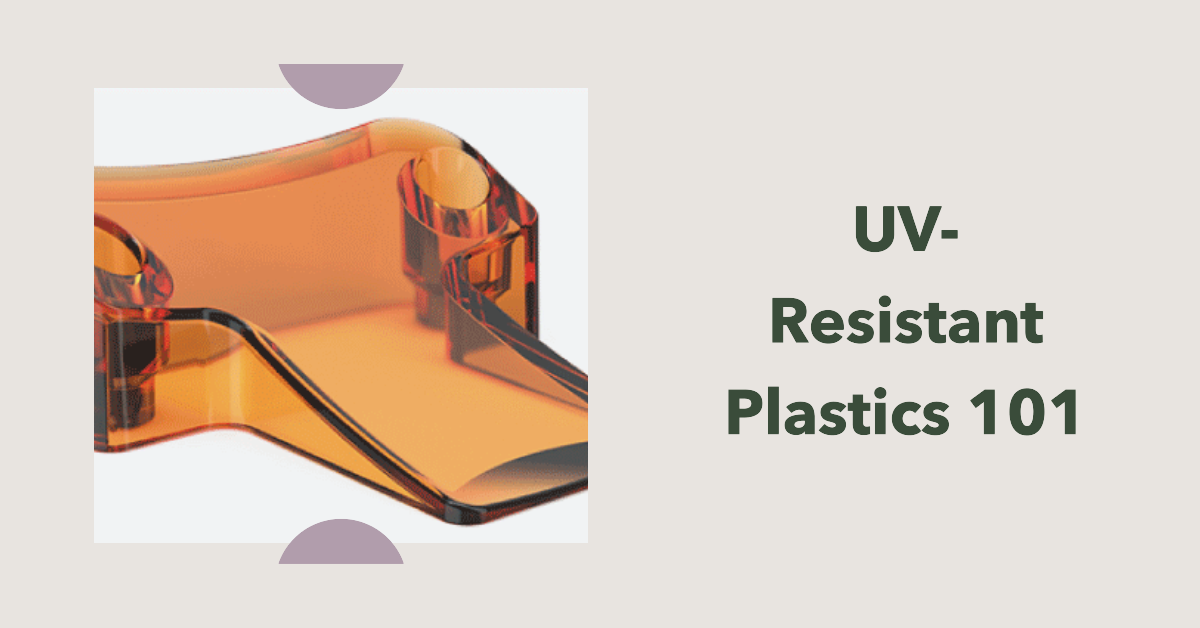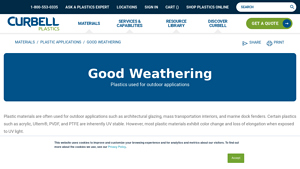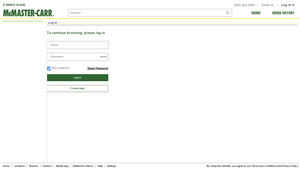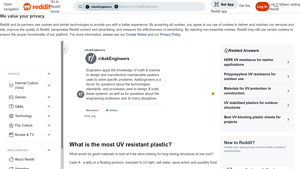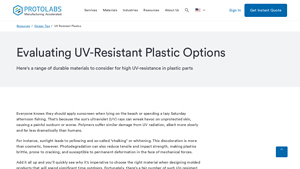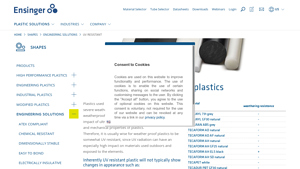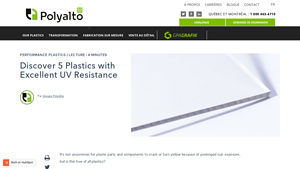Uv Resistant Plastics Guide: Type, Cost, Top List…
Introduction: Navigating the Global Market for uv resistant plastics
In today’s competitive landscape, sourcing UV-resistant plastics that withstand harsh environmental conditions presents a significant challenge for B2B buyers. The degradation caused by ultraviolet (UV) radiation can compromise product integrity and performance, leading to increased costs and customer dissatisfaction. This guide aims to simplify the sourcing process by offering a comprehensive overview of the types of UV-resistant plastics available, their various applications, and key considerations for supplier vetting and cost evaluation.
From acrylic and polycarbonate to high-density polyethylene (HDPE) and polyvinylidene fluoride (PVDF), each material offers unique advantages and varying degrees of UV resistance, making them suitable for outdoor applications in diverse industries. This guide will empower international B2B buyers, particularly those from Africa, South America, the Middle East, and Europe—including countries like Germany and Brazil—to make informed purchasing decisions.
By understanding the properties, applications, and potential enhancements for UV resistance, buyers can strategically select materials that align with their specific needs. With actionable insights and expert advice, this guide serves as a valuable resource for navigating the global market for UV-resistant plastics, ensuring that your investment not only meets but exceeds industry standards for durability and performance.
Understanding uv resistant plastics Types and Variations
| Type Name | Key Distinguishing Features | Primary B2B Applications | Brief Pros & Cons for Buyers |
|---|---|---|---|
| Acrylic | Inherently UV-resistant, good scratch resistance | Outdoor signage, displays, light fixtures | Pros: Excellent clarity and UV resistance. Cons: Brittle, not suitable for load-bearing applications. |
| High Density Polyethylene (HDPE) | Durable, soft, resistant to acids and UV radiation | Playground equipment, outdoor furniture, chemical containers | Pros: Cost-effective, resistant to wear. Cons: Limited strength compared to other options. |
| Polycarbonate | High impact resistance, good thermal stability | Safety equipment, automotive parts, heavy-duty products | Pros: Strong and durable. Cons: Higher cost than alternatives. |
| Polyamide-Imide (PAI) | Exceptional UV resistance, high melting point | Surgical instruments, magnet wires, high-precision components | Pros: Excellent strength and wear resistance. Cons: Expensive and requires post-curing. |
| Polyvinylidene Fluoride (PVDF) | Superior chemical resistance, good thermal stability | Chemical tank liners, piping, seals, gaskets | Pros: Highly durable and versatile. Cons: More expensive than standard plastics. |
What are the Characteristics of Acrylic as a UV-Resistant Plastic?
Acrylic stands out as one of the few plastics that are inherently UV-resistant, exhibiting minimal degradation over extended periods. Its clarity and scratch resistance make it ideal for applications such as outdoor signage and light fixtures. However, buyers must consider its brittleness; while it excels in aesthetic applications, it is not suited for structural or load-bearing components.
How Does High Density Polyethylene (HDPE) Perform in Outdoor Environments?
HDPE is valued for its durability and resistance to various environmental factors, including UV radiation. It is commonly used in applications like playground equipment and outdoor furniture due to its soft texture that prevents sharp edges when broken. Although it offers good resistance to wear and weathering, its strength is somewhat limited compared to more robust materials, making it less suitable for high-pressure applications.
What Advantages Does Polycarbonate Offer for B2B Buyers?
Polycarbonate is known for its exceptional impact resistance and thermal stability, making it a preferred choice for safety equipment and automotive parts. Its ability to withstand harsh conditions without significant degradation is a major selling point. However, its higher price point may deter some buyers, especially when budget constraints are a consideration. For applications where durability is paramount, the investment in polycarbonate can be justified.
Why Choose Polyamide-Imide (PAI) for High-Performance Applications?
PAI is a high-performance thermoplastic that offers remarkable UV resistance, making it suitable for demanding applications like surgical instruments and magnet wires. Its unique combination of strength, wear resistance, and thermal stability makes it a valuable material in precision engineering. However, its higher cost and the need for post-curing processes may pose challenges for budget-conscious buyers.
What Makes Polyvinylidene Fluoride (PVDF) a Versatile Option?
PVDF is recognized for its outstanding chemical resistance and thermal stability, making it ideal for applications such as chemical tank liners and piping systems. Its ability to withstand UV radiation while maintaining performance under extreme conditions adds to its appeal. Although it is generally more expensive than traditional plastics, its long-term durability can lead to cost savings in maintenance and replacement, making it a wise investment for many industries.
Key Industrial Applications of uv resistant plastics
| Industry/Sector | Specific Application of UV Resistant Plastics | Value/Benefit for the Business | Key Sourcing Considerations for this Application |
|---|---|---|---|
| Construction | Architectural Glazing and Facades | Enhances aesthetic appeal while providing durability against UV degradation. | Ensure compliance with local building codes and UV resistance standards. |
| Transportation | Mass Transportation Interiors (buses, trains) | Improves passenger comfort and safety while maintaining structural integrity. | Consider weight, impact resistance, and ease of maintenance. |
| Agriculture | Greenhouse Films and Covers | Protects plants from harmful UV rays while allowing optimal light penetration. | Evaluate material thickness, UV stability, and temperature resistance. |
| Marine | Dock Fenders and Marine Equipment | Provides long-lasting performance in harsh marine environments, reducing replacement costs. | Assess chemical resistance and compatibility with marine conditions. |
| Consumer Products | Outdoor Furniture and Toys | Increases product lifespan and customer satisfaction by resisting fading and wear. | Focus on color retention, ease of cleaning, and safety standards. |
How Are UV Resistant Plastics Used in Construction?
In the construction industry, UV resistant plastics are commonly used for architectural glazing and facades. These materials not only enhance the aesthetic appeal of buildings but also provide vital protection against UV degradation, which can lead to discoloration and structural weaknesses over time. International buyers, particularly from regions with high UV exposure, should consider sourcing materials that comply with local building codes and offer guaranteed UV resistance to ensure durability and long-term performance.
What Role Do UV Resistant Plastics Play in Transportation?
Mass transportation interiors, including buses and trains, utilize UV resistant plastics to improve passenger comfort and safety. These materials withstand UV exposure without losing their structural integrity or aesthetic qualities, reducing maintenance and replacement costs. Buyers must consider factors such as weight, impact resistance, and ease of cleaning when sourcing these materials, especially in regions with varying climate conditions.
Why Are UV Resistant Plastics Essential in Agriculture?
In agriculture, UV resistant plastics are essential for greenhouse films and covers, protecting crops from harmful UV rays while allowing optimal light penetration for growth. This application not only enhances crop yield but also prolongs the lifespan of the greenhouse structure. Buyers should evaluate the material’s thickness, UV stability, and temperature resistance to ensure it meets specific agricultural needs, particularly in regions with extreme weather conditions.
How Do UV Resistant Plastics Benefit Marine Applications?
Marine applications, such as dock fenders and equipment, benefit significantly from UV resistant plastics due to their ability to withstand harsh marine environments. These materials provide long-lasting performance, reducing the need for frequent replacements and associated costs. When sourcing for this application, it is crucial to assess the material’s chemical resistance and compatibility with marine conditions, especially in regions prone to corrosion and harsh weather.
What Advantages Do UV Resistant Plastics Offer in Consumer Products?
In the consumer products sector, UV resistant plastics are widely used for outdoor furniture and toys. These materials enhance product lifespan by resisting fading and wear from UV exposure, ultimately increasing customer satisfaction. Buyers should focus on factors such as color retention, ease of cleaning, and compliance with safety standards to ensure the products meet consumer expectations, particularly in sunny regions where outdoor use is prevalent.
3 Common User Pain Points for ‘uv resistant plastics’ & Their Solutions
Scenario 1: Ensuring Longevity in Outdoor Applications
The Problem: B2B buyers often face the challenge of selecting materials that can withstand prolonged exposure to UV radiation, particularly for outdoor applications such as signage, playground equipment, and automotive components. Without proper UV resistance, these materials may degrade, leading to discoloration, brittleness, and structural failure. This not only affects the aesthetic appeal of the products but also poses significant safety risks and increases replacement costs.
The Solution: To mitigate these risks, it is crucial to choose inherently UV-resistant materials, such as acrylic, polycarbonate, or high-density polyethylene (HDPE). When sourcing these materials, buyers should ensure they are accompanied by UV stabilizers or additives that enhance their resistance to photodegradation. For instance, specifying acrylic with titanium dioxide or carbon black can significantly improve its longevity under sunlight. Additionally, conducting thorough testing for UV exposure in real-world conditions can provide insights into the expected performance of the materials. Collaborating with suppliers who offer comprehensive testing data and performance guarantees can further ensure that the selected materials will meet the required standards for outdoor durability.
Scenario 2: Balancing Cost and Performance in Material Selection
The Problem: Many businesses are often caught in a dilemma between choosing cost-effective UV-resistant plastics and those that provide superior performance. While cheaper options may initially seem attractive, they can lead to higher long-term costs due to frequent replacements and maintenance, especially in harsh environments. This scenario is particularly prevalent in industries such as construction and agriculture, where materials face extreme weather conditions.
The Solution: Buyers should conduct a total cost of ownership (TCO) analysis before making a decision. This involves evaluating not only the initial purchase price but also potential maintenance, replacement, and operational costs associated with each material option. For example, while polycarbonate may come at a higher upfront cost than HDPE, its superior impact resistance and UV longevity may lead to lower replacement rates and maintenance costs over time. Additionally, seeking out suppliers that offer bulk purchasing discounts or custom solutions can help offset initial costs while ensuring quality. Engaging in discussions with material experts can also provide valuable insights into the best balance of cost and performance for specific applications.
Scenario 3: Adapting to Regional UV Intensity Variations
The Problem: B2B buyers in regions with high UV intensity, such as parts of Africa and South America, may struggle with sourcing UV-resistant plastics that are suitable for their specific environmental conditions. The variance in UV exposure levels can lead to inconsistent performance and durability of materials, leading to dissatisfaction and increased risk of product failure in the field.
The Solution: To address this issue, buyers should work closely with manufacturers who have experience in their local markets and understand regional UV exposure levels. It is important to specify materials that are tailored to withstand the specific UV conditions of their region. For instance, using PVDF or specially treated acrylics can provide enhanced protection against extreme UV radiation. Additionally, buyers should request samples for testing in real-world conditions prior to full-scale procurement. Establishing a long-term relationship with suppliers who can provide ongoing support and insights into new UV-resistant technologies will also be beneficial in adapting to changing environmental conditions. Regularly reviewing performance data and customer feedback can help ensure that the chosen materials continue to meet the necessary standards over time.
Strategic Material Selection Guide for uv resistant plastics
What Are the Key Properties of Acrylic for UV Resistance?
Acrylic is a transparent thermoplastic known for its inherent UV resistance, making it a popular choice for outdoor applications. It can endure only about 3% degradation over a decade when exposed to UV rays, which is significantly lower than many other plastics. Acrylic also boasts good scratch resistance, enhancing its durability in outdoor settings. However, its rigidity makes it less suitable for load-bearing applications, which can be a critical consideration for manufacturers.
From a B2B perspective, acrylic is commonly used in signage, light fixtures, and decorative panels. Its low cost and ease of fabrication make it attractive for businesses looking for economical solutions. However, international buyers should be aware of compliance with standards such as ASTM and DIN, particularly in Europe and the Middle East, where material certifications are often required.
How Does High-Density Polyethylene (HDPE) Perform Under UV Exposure?
High-Density Polyethylene (HDPE) is another widely used UV-resistant plastic, particularly valued for its strength and versatility. It exhibits excellent resistance to acids and bases, making it suitable for a variety of outdoor applications, including playground equipment and outdoor furniture. HDPE is also resistant to photodegradation, which is essential for maintaining aesthetic quality over time.
The main advantages of HDPE include its durability and low cost, making it an economical choice for large-scale projects. However, it is not as strong as some alternatives, limiting its use in high-pressure applications. For international buyers, especially in regions like Africa and South America, understanding local manufacturing capabilities and compliance with safety standards is crucial.
Why Choose Polycarbonate for UV Resistance in Heavy-Duty Applications?
Polycarbonate is renowned for its exceptional impact resistance and strength, making it ideal for demanding applications such as safety goggles and helmets. It also offers comparable transparency to acrylic, along with good UV resistance, although it is generally more expensive. This material can withstand significant temperature fluctuations, which is beneficial in diverse climates.
While polycarbonate’s durability justifies its higher cost for many applications, its complexity in manufacturing can be a drawback. Companies looking to source polycarbonate products should consider the availability of skilled labor and equipment in their region to ensure quality production. Compliance with international standards, particularly in Europe, can also influence procurement decisions.
What Are the Advantages of Polyvinylidene Fluoride (PVDF) for UV Resistance?
Polyvinylidene Fluoride (PVDF) is a high-performance plastic that excels in UV resistance, thermal stability, and chemical resistance. Its versatility allows it to be used in various applications, including chemical tank liners and piping systems. PVDF’s ability to withstand harsh environments makes it a preferred choice for industries that require robust materials.
However, PVDF is generally more expensive than other UV-resistant plastics, which can impact budget considerations for B2B buyers. Additionally, its specific processing requirements may necessitate specialized manufacturing capabilities. For international buyers, particularly in the Middle East and Africa, understanding the local supply chain and compliance with relevant standards is essential to ensure product quality and reliability.
Summary of Strategic Material Selection for UV Resistant Plastics
| Material | Typical Use Case for UV Resistant Plastics | Key Advantage | Key Disadvantage/Limitation | Relative Cost (Low/Med/High) |
|---|---|---|---|---|
| Acrylic | Outdoor signage, light fixtures | Inherent UV resistance, low degradation | Brittle, not suitable for load-bearing | Low |
| High-Density Polyethylene (HDPE) | Playground equipment, outdoor furniture | Durable, economical | Limited strength for high-pressure use | Low |
| Polycarbonate | Safety goggles, helmets | Exceptional impact resistance | Higher cost, complex manufacturing | High |
| Polyvinylidene Fluoride (PVDF) | Chemical tank liners, piping systems | Excellent thermal and chemical resistance | Higher cost, specialized processing needed | High |
This guide aims to equip international B2B buyers with the necessary insights to make informed decisions regarding UV-resistant plastics, ensuring that material selection aligns with application requirements and regional compliance standards.
In-depth Look: Manufacturing Processes and Quality Assurance for uv resistant plastics
What Are the Key Manufacturing Processes for UV Resistant Plastics?
Manufacturing UV resistant plastics involves a series of well-defined stages, each critical to ensuring the final product meets the required performance standards. The main stages in the manufacturing process include material preparation, forming, assembly, and finishing.
How Is Material Prepared for UV Resistant Plastics?
The first step in the manufacturing process is material preparation. This involves selecting the appropriate base polymer, such as acrylic, polycarbonate, or HDPE, which inherently possess good UV resistance. Suppliers often enhance these materials by adding UV stabilizers or absorbers during this stage. These additives help to minimize photodegradation and improve the longevity of the plastics when exposed to UV radiation.
Proper blending of these materials is essential to ensure uniform distribution of the UV stabilizers. Advanced techniques like twin-screw extrusion are commonly used to achieve this, allowing for precise control over the mixing process. This stage lays the groundwork for the subsequent forming processes.
What Techniques Are Used in Forming UV Resistant Plastics?
The forming stage encompasses various techniques, including injection molding, blow molding, and thermoforming. Each method has its own advantages depending on the specific application and desired characteristics of the final product.
-
Injection Molding: This is one of the most widely used methods for producing complex shapes with high precision. It allows for high production rates and is particularly effective for producing items like automotive components and outdoor fixtures.
-
Blow Molding: Often used for hollow products, this technique is suitable for creating bottles and containers that require UV resistance. The process involves inflating a heated plastic tube into a mold, ensuring uniform thickness and strength.
-
Thermoforming: This technique is ideal for producing large sheets or panels. The plastic sheet is heated until pliable and then formed over a mold, making it a popular choice for applications like outdoor signage and architectural elements.
Each forming technique requires close monitoring to ensure that the UV stabilizers remain effective and that the material maintains its desired properties throughout the process.
What Steps Are Involved in the Assembly of UV Resistant Plastic Products?
Assembly involves the integration of various components into the final product. This stage may include welding, adhesive bonding, or mechanical fastening. For UV resistant plastics, it is crucial to use adhesives and fasteners that also provide UV resistance to ensure the durability of the assembled product.
For instance, in the case of outdoor furniture, components may be joined using UV-resistant adhesives that can withstand harsh environmental conditions. The assembly process should be monitored to ensure that the integrity of the UV protection is not compromised, especially at joints or seams where exposure is likely.
How Is Finishing Applied to UV Resistant Plastics?
Finishing is the final stage of the manufacturing process and may include surface treatments, coatings, or additional UV protective layers. Finishing techniques can enhance aesthetic appeal, improve resistance to scratching, and provide additional UV protection.
Common finishing methods include:
-
Coating: Applying a UV-resistant coating can further enhance the material’s longevity and aesthetic. This may involve spray-on coatings or lamination techniques that add a protective layer to the surface.
-
Polishing: For products where clarity is essential, such as lenses or displays, polishing can be employed to improve transparency and reduce surface imperfections.
-
Printing and Engraving: Many products require branding or information to be displayed, which can be done using UV-resistant inks or engraving techniques to ensure durability.
What Quality Assurance Measures Are Essential for UV Resistant Plastics?
Quality assurance (QA) is vital throughout the manufacturing process to ensure that the final products meet international standards and specific customer requirements. For B2B buyers, understanding the quality assurance protocols of their suppliers is critical.
Which International Standards Should Be Considered?
International standards such as ISO 9001 for quality management systems are crucial in ensuring a consistent level of quality. Additionally, industry-specific certifications like CE marking for products sold in Europe or API standards for materials used in the petroleum industry may apply. These standards provide a framework for continuous improvement and customer satisfaction.
What Are the Key QC Checkpoints in Manufacturing?
Quality control (QC) involves multiple checkpoints throughout the manufacturing process:
-
Incoming Quality Control (IQC): This stage involves inspecting raw materials and additives before they enter the production line. Ensuring that UV stabilizers and base polymers meet specifications is crucial to the product’s performance.
-
In-Process Quality Control (IPQC): During manufacturing, regular inspections help identify any deviations from the desired process parameters. This can include monitoring temperature, pressure, and material flow rates.
-
Final Quality Control (FQC): After production, the finished products undergo rigorous testing to ensure they meet the required specifications. This may include mechanical testing, UV exposure tests, and visual inspections for defects.
How Can B2B Buyers Verify Supplier Quality Control?
B2B buyers should actively engage in verifying the quality assurance processes of their suppliers. This can be done through:
-
Audits: Conducting regular audits of the supplier’s facilities can provide insights into their quality management practices and adherence to international standards.
-
Quality Reports: Requesting detailed quality reports and certifications can help assess the supplier’s compliance with relevant standards.
-
Third-Party Inspections: Engaging independent inspection agencies can provide an unbiased evaluation of the supplier’s quality control processes and product quality.
What Are the Unique QC Considerations for International Buyers?
International buyers, particularly those in regions like Africa, South America, the Middle East, and Europe, must be aware of nuances in quality control practices. Local regulations, environmental standards, and market expectations can vary significantly. Buyers should ensure that suppliers are compliant not only with international standards but also with local regulations that may impact product performance and safety.
In summary, the manufacturing processes and quality assurance measures for UV resistant plastics are critical components for B2B buyers to consider. By understanding these processes and actively engaging with suppliers, buyers can ensure they receive high-quality products that meet their specific needs for durability and performance in outdoor applications.
Practical Sourcing Guide: A Step-by-Step Checklist for ‘uv resistant plastics’
Introduction
This guide serves as a comprehensive checklist for B2B buyers looking to source UV-resistant plastics. With the increasing demand for durable materials that can withstand harsh environmental conditions, understanding how to effectively procure these plastics is crucial for ensuring product longevity and performance in outdoor applications.
Step 1: Define Your Technical Specifications
Before initiating the sourcing process, clearly outline your technical requirements for UV-resistant plastics. Consider factors such as the specific application, environmental exposure, and necessary mechanical properties.
– Application Type: Identify whether the plastic will be used in outdoor signage, automotive components, or industrial settings.
– Performance Metrics: Specify requirements such as impact resistance, thermal stability, and elongation properties.
Step 2: Research Available Materials
Familiarize yourself with the various types of UV-resistant plastics suitable for your needs. Common options include Acrylic, HDPE, Polycarbonate, PAI, and PVDF, each offering unique properties.
– Material Characteristics: Understand how each type performs under UV exposure and in specific applications.
– Cost vs. Performance: Balance the material’s cost with its performance attributes to ensure optimal value for your investment.
Step 3: Evaluate Potential Suppliers
Conduct thorough due diligence on suppliers before making a commitment. Look for companies with a proven track record in supplying high-quality UV-resistant plastics.
– Company Credentials: Request company profiles, certifications, and case studies that demonstrate their expertise and reliability.
– Customer Feedback: Seek references from similar industries or regions to gauge customer satisfaction and product performance.
Step 4: Assess Compliance with Industry Standards
Ensure that the materials you are considering meet relevant industry standards and regulations. This is particularly important if your applications are subject to specific safety or environmental criteria.
– Certifications: Check for certifications such as ISO, ASTM, or other relevant quality assurance standards.
– Testing Documentation: Request test results that confirm the UV resistance and durability of the plastics.
Step 5: Request Samples for Testing
Before finalizing your order, obtain samples of the UV-resistant plastics you are considering. Testing these samples in real-world conditions can provide valuable insights into their performance.
– Performance Testing: Evaluate the samples for color stability, impact resistance, and mechanical properties after exposure to UV light.
– Compatibility Assessment: Ensure the selected plastics are compatible with any additional components or processes in your application.
Step 6: Negotiate Terms and Conditions
Once you have selected a supplier, it’s time to negotiate the terms of your purchase. This includes pricing, lead times, and any warranties or guarantees.
– Pricing Transparency: Ensure you understand the pricing structure, including any potential hidden costs.
– Delivery and Support: Discuss lead times and after-sales support to ensure timely delivery and assistance if issues arise.
Step 7: Establish a Long-Term Partnership
Finally, consider establishing a long-term relationship with your chosen supplier. A reliable partnership can lead to better pricing, priority access to new materials, and enhanced support.
– Ongoing Communication: Maintain open lines of communication to address any future needs or challenges.
– Collaboration Opportunities: Explore opportunities for joint development projects or customized solutions that cater to your specific requirements.
By following this practical checklist, B2B buyers can effectively navigate the procurement process for UV-resistant plastics, ensuring they select the right materials for their applications while building strong supplier relationships.
Comprehensive Cost and Pricing Analysis for uv resistant plastics Sourcing
What Are the Key Cost Components of UV Resistant Plastics?
When sourcing UV resistant plastics, it is essential to understand the various components that contribute to the overall cost structure. The primary cost elements include:
-
Materials: The choice of polymer significantly impacts the cost. For instance, acrylic and HDPE are generally more affordable than high-performance options like polyamide-imide (PAI) and polycarbonate, which offer superior durability and UV resistance.
-
Labor: Labor costs vary based on the complexity of manufacturing processes. Advanced plastics may require skilled labor for specialized techniques, which can increase production costs.
-
Manufacturing Overhead: This includes costs associated with machinery, utilities, and facility maintenance. Manufacturers with more advanced technologies may incur higher overhead but can achieve greater efficiency and quality.
-
Tooling: Initial tooling costs can be substantial, especially for custom molds. These costs should be amortized over production volume, making them more manageable for larger orders.
-
Quality Control (QC): Investing in rigorous QC processes ensures that the final products meet specified standards, which is critical for applications exposed to harsh environments. Enhanced QC may lead to higher upfront costs but can reduce long-term liabilities.
-
Logistics: Transportation and storage costs are influenced by the geographical location of suppliers and buyers, along with the chosen shipping methods. International logistics can add complexity and costs, particularly for bulk shipments.
-
Margin: Suppliers typically factor in profit margins, which can vary based on market conditions and competition.
How Do Price Influencers Affect the Cost of UV Resistant Plastics?
Several factors can influence the pricing of UV resistant plastics, particularly for international B2B buyers:
-
Volume and Minimum Order Quantity (MOQ): Larger orders generally lead to lower per-unit costs. Suppliers may offer significant discounts for bulk purchases, making it beneficial for buyers to assess their needs carefully.
-
Specifications and Customization: Customized solutions tailored to specific applications often come at a premium. Clear communication of specifications can help avoid unexpected costs and delays.
-
Materials: The choice of materials not only affects initial costs but also long-term performance and maintenance expenses. For example, while polycarbonate may have a higher upfront cost, its durability can lead to lower Total Cost of Ownership (TCO) over time.
-
Quality and Certifications: Products that meet stringent quality standards or possess relevant certifications may carry higher prices. However, these certifications often ensure reliability and compliance with regulatory requirements, which is crucial for certain industries.
-
Supplier Factors: The reputation and reliability of suppliers can impact pricing. Established suppliers may charge more but offer better quality assurance and customer service.
-
Incoterms: The chosen Incoterms (International Commercial Terms) can significantly affect logistics costs and responsibilities. Understanding these terms is vital for accurate budgeting.
What Negotiation Strategies Can Help International Buyers Secure Better Prices?
International buyers should consider several strategies to enhance cost-efficiency when sourcing UV resistant plastics:
-
Understand Total Cost of Ownership (TCO): Evaluate all costs associated with a product over its lifecycle, including maintenance and replacement costs, to make informed purchasing decisions.
-
Leverage Volume Discounts: Negotiating terms for larger orders can lead to significant savings. Buyers should explore options for consolidating orders to meet MOQs without overcommitting.
-
Engage Multiple Suppliers: Obtaining quotes from various suppliers can create competition and provide leverage during negotiations.
-
Build Long-Term Relationships: Establishing ongoing partnerships with suppliers may lead to better pricing, priority service, and access to new materials or technologies.
-
Stay Informed on Market Trends: Understanding market dynamics, such as fluctuations in raw material prices, can provide insights for better negotiation strategies.
What Should International Buyers Keep in Mind Regarding Pricing Nuances?
For buyers from regions such as Africa, South America, the Middle East, and Europe, it is vital to consider specific pricing nuances:
-
Currency Fluctuations: Exchange rate volatility can impact costs. Locking in prices or using forward contracts may mitigate risks.
-
Import Duties and Tariffs: Understanding local regulations and potential tariffs can prevent unexpected expenses upon importing goods.
-
Cultural Differences: Negotiation styles and business practices vary by region. Adapting to local customs can facilitate smoother transactions.
-
Legal Considerations: Ensuring compliance with international trade laws and regulations can prevent costly legal issues down the line.
In conclusion, a comprehensive understanding of cost components, pricing influencers, and negotiation strategies will empower international B2B buyers to make informed decisions when sourcing UV resistant plastics. Always seek to establish clear communication with suppliers and stay updated on market trends to optimize purchasing outcomes.
Alternatives Analysis: Comparing uv resistant plastics With Other Solutions
Understanding Alternatives to UV Resistant Plastics
When it comes to protecting products from the damaging effects of ultraviolet (UV) radiation, UV resistant plastics are a popular choice. However, they are not the only solution available. As B2B buyers evaluate their options, it’s crucial to consider alternatives that may offer similar or enhanced protection, depending on specific application needs. This analysis compares UV resistant plastics with two viable alternatives: glass and metal coatings.
Comparison Table
| Comparison Aspect | UV Resistant Plastics | Glass | Metal Coatings |
|---|---|---|---|
| Performance | High UV resistance, good impact strength | Excellent UV protection, durable | Good UV protection, corrosion resistance |
| Cost | Moderate to high, depending on type | Generally higher due to fragility and installation | Lower initial cost but may require frequent maintenance |
| Ease of Implementation | Easy to mold and fabricate | Requires precise cutting and handling | Requires skilled application, often complex |
| Maintenance | Low, but may degrade over time | Low, but can shatter or scratch | Medium; may need reapplication or touch-ups |
| Best Use Case | Outdoor applications, signage, furniture | Architectural glazing, safety features | Industrial settings, outdoor structures |
In-Depth Analysis of Alternatives
How Does Glass Compare to UV Resistant Plastics?
Glass is renowned for its superior UV protection and durability, making it an ideal choice for applications like architectural glazing and safety features. While glass does not degrade under UV exposure, it is prone to shattering and requires careful handling during installation. The initial investment in glass can be higher than UV resistant plastics, particularly when considering installation costs. However, glass provides excellent aesthetic value and long-term performance without the risk of fading or chemical degradation.
What Are the Benefits and Drawbacks of Metal Coatings?
Metal coatings, such as aluminum or zinc-based options, can offer a cost-effective solution with good UV protection and corrosion resistance. They are particularly suited for industrial applications where exposure to harsh environments is common. The initial cost of metal coatings is typically lower than UV resistant plastics, but they may require more frequent maintenance and reapplication to maintain their protective properties. Additionally, the application process can be complex, requiring skilled labor to ensure effectiveness and longevity.
How to Choose the Right Solution for Your Needs
Selecting the appropriate material for UV protection depends on various factors including application, environmental conditions, budget, and aesthetic requirements. B2B buyers should assess the specific demands of their projects, such as whether the material will be exposed to extreme conditions or require a particular visual appeal. Consulting with material experts can provide deeper insights into how each option aligns with operational goals and cost-effectiveness, ultimately guiding buyers toward the best choice for their unique needs.
Essential Technical Properties and Trade Terminology for uv resistant plastics
What Are the Key Technical Properties of UV-Resistant Plastics?
When selecting UV-resistant plastics for your business needs, understanding specific technical properties is crucial. Here are some essential specifications to consider:
-
Material Grade
Material grade refers to the classification of the plastic based on its composition and performance characteristics. For UV-resistant plastics, different grades can significantly affect durability and resistance to photodegradation. Selecting the right material grade ensures the product meets the required performance standards for its intended application, particularly in outdoor environments. -
Tensile Strength
This property measures the maximum amount of tensile (pulling) stress that a material can withstand before failure. For UV-resistant plastics, tensile strength is critical as it impacts the longevity and structural integrity of components exposed to harsh sunlight. Higher tensile strength indicates better performance in outdoor applications, reducing the risk of failure due to UV-induced brittleness. -
Elongation at Break
Elongation at break refers to the percentage increase in length a material can undergo before it fractures. This property is essential for UV-resistant plastics used in applications that experience dynamic loads or movement. Materials with high elongation at break can better absorb shocks and resist cracking, making them ideal for environments with fluctuating temperatures and UV exposure. -
UV Stabilization
This specification indicates whether the plastic has been treated or formulated with additives to enhance its resistance to UV radiation. UV stabilization can prolong the life of the material and maintain its aesthetic and mechanical properties. Understanding the level of UV stabilization helps buyers select materials that will perform optimally over time, particularly in regions with intense sunlight. -
Impact Resistance
Impact resistance is a measure of a material’s ability to withstand sudden forces or impacts without breaking. For outdoor applications, this property is vital as UV exposure can weaken plastics, making them more prone to damage. High impact resistance ensures that the plastic can endure environmental stresses, thus enhancing product reliability.
What Are Common Trade Terms Related to UV-Resistant Plastics?
Navigating the world of UV-resistant plastics involves familiarizing yourself with specific trade terminology. Here are some common terms that B2B buyers should know:
-
OEM (Original Equipment Manufacturer)
An OEM refers to a company that produces parts or equipment that may be marketed by another manufacturer. In the context of UV-resistant plastics, understanding OEM relationships can help businesses source quality materials that meet specific design and performance requirements. -
MOQ (Minimum Order Quantity)
MOQ is the smallest quantity of a product that a supplier is willing to sell. For UV-resistant plastics, MOQs can impact inventory management and cost efficiency. Buyers should negotiate MOQs to ensure they can acquire sufficient materials for their projects without overcommitting resources. -
RFQ (Request for Quotation)
An RFQ is a document that a buyer sends to suppliers requesting pricing and terms for specific products. When dealing with UV-resistant plastics, an RFQ can help businesses compare options and secure competitive pricing while ensuring that the materials meet their technical specifications. -
Incoterms (International Commercial Terms)
Incoterms define the responsibilities of buyers and sellers in international trade, particularly concerning shipping and delivery. Familiarity with Incoterms is essential for B2B buyers sourcing UV-resistant plastics globally, as they dictate costs, risks, and responsibilities involved in the transportation of goods. -
Lead Time
Lead time is the duration from placing an order to receiving the product. Understanding lead times is crucial for businesses planning their production schedules, especially when sourcing specialized UV-resistant plastics that may require longer manufacturing processes or international shipping.
By grasping these technical properties and trade terms, international B2B buyers can make more informed decisions when sourcing UV-resistant plastics, ensuring they select the right materials for their specific applications.
Navigating Market Dynamics and Sourcing Trends in the uv resistant plastics Sector
What Are the Current Market Dynamics and Key Trends in the UV Resistant Plastics Sector?
The UV resistant plastics market is experiencing significant growth, driven by a surge in outdoor applications across various industries, including construction, automotive, and consumer goods. With increasing awareness of the adverse effects of UV radiation on materials, international B2B buyers are increasingly sourcing plastics that offer enhanced durability and longevity. Key trends include the adoption of advanced manufacturing technologies, such as additive manufacturing and injection molding, which allow for the production of more complex and customized UV resistant components. Moreover, the integration of smart technologies in manufacturing processes is becoming prevalent, enabling better tracking and quality assurance throughout the supply chain.
In regions such as Africa, South America, the Middle East, and Europe, buyers are particularly focused on sourcing materials that can withstand harsh environmental conditions. For instance, in Europe, regulatory pressures are pushing companies toward sustainable sourcing practices, while in Africa, the growing demand for outdoor infrastructure is driving the need for robust UV resistant plastics. Additionally, the emergence of new materials, such as bio-based UV resistant plastics, is gaining traction as companies look to innovate while adhering to sustainability goals.
How Are Sustainability and Ethical Sourcing Influencing the UV Resistant Plastics Market?
The environmental impact of plastic production and disposal is under scrutiny, prompting a shift toward sustainability in the UV resistant plastics sector. International B2B buyers are increasingly prioritizing suppliers who demonstrate a commitment to ethical sourcing and environmental responsibility. This includes sourcing materials that minimize carbon footprints and utilizing recycled plastics where possible.
Certifications such as ISO 14001 (Environmental Management) and the Global Recycling Standard (GRS) are becoming critical in supplier evaluations, ensuring that companies meet stringent sustainability criteria. Additionally, the demand for ‘green’ materials, such as those derived from renewable sources or incorporating biodegradable additives, is on the rise. For B2B buyers, aligning with suppliers who can offer these certifications not only enhances their brand reputation but also appeals to a growing consumer base that values sustainability.
What Is the Historical Context of UV Resistant Plastics and Their Evolution?
The development of UV resistant plastics can be traced back to the mid-20th century when manufacturers began to recognize the detrimental effects of UV radiation on traditional plastic materials. Initially, simple additives were introduced to enhance UV resistance, but as applications expanded, so did the complexity of the formulations. By the 1980s, advancements in polymer chemistry allowed for the creation of inherently UV stable materials, such as polycarbonate and acrylic, which became widely adopted in various sectors.
Over the years, the market has evolved to include a diverse range of options that cater to specific applications, from outdoor signage to protective equipment. The ongoing research into bio-based and recycled plastics signals a new chapter in the history of UV resistant materials, aligning with the global push for sustainability and responsible manufacturing. As this sector continues to evolve, international B2B buyers will benefit from staying informed about both historical advancements and emerging technologies that can enhance their product offerings.
Frequently Asked Questions (FAQs) for B2B Buyers of uv resistant plastics
-
How do I select the right UV-resistant plastic for my application?
Choosing the right UV-resistant plastic involves assessing the specific requirements of your application. Factors to consider include the environmental conditions (e.g., exposure duration, temperature fluctuations), mechanical properties needed (e.g., strength, flexibility), and any regulatory standards applicable in your region. Materials like acrylic and polycarbonate are excellent for applications requiring transparency and impact resistance, while HDPE offers durability for outdoor structures. Consulting with suppliers for samples and detailed specifications can greatly assist in making an informed decision. -
What is the best UV-resistant plastic for outdoor signage?
Acrylic is often the best choice for outdoor signage due to its inherent UV resistance and clarity, which allows for vibrant colors and visibility. It experiences minimal degradation over time, maintaining its aesthetic appeal. Polycarbonate is also a viable option, particularly in applications requiring higher impact resistance. When selecting a material, consider adding UV stabilizers to enhance longevity and performance in direct sunlight. -
How can I improve the UV resistance of my existing plastic products?
To enhance the UV resistance of existing plastic products, consider applying UV-resistant additives or coatings. These include UV absorbers, stabilizers, or blockers that can be mixed into the resin or applied as a surface treatment. Additionally, using protective caps or films can shield the material from direct sunlight. It’s essential to consult with a materials specialist to determine the most effective method based on your product’s composition and intended use. -
What are the minimum order quantities (MOQs) for UV-resistant plastics?
Minimum order quantities (MOQs) for UV-resistant plastics can vary significantly among suppliers. Generally, MOQs may range from 100 kg to several tons, depending on the material type, customization requirements, and the supplier’s production capabilities. For smaller projects, some suppliers may offer flexibility or stock items without MOQs. Always discuss your specific needs with potential suppliers to negotiate suitable terms. -
What payment terms should I expect when sourcing UV-resistant plastics internationally?
Payment terms for international sourcing of UV-resistant plastics typically include options like advance payment, letter of credit, or payment upon delivery. Commonly, suppliers may request a partial payment upfront (e.g., 30-50%) with the balance due upon shipment or delivery. It’s vital to clarify terms upfront and ensure they align with your company’s cash flow and risk management strategies. Always review payment options with legal and financial advisors to mitigate potential risks. -
How do I vet suppliers of UV-resistant plastics?
Vetting suppliers is crucial for ensuring quality and reliability. Start by researching their industry reputation through reviews, testimonials, and case studies. Request samples to evaluate material performance and quality. Additionally, assess their certifications (e.g., ISO, ASTM) to ensure compliance with international standards. Engaging in direct communication can provide insights into their responsiveness and customer service. Consider visiting their facilities if feasible or utilizing third-party assessment services for a thorough evaluation. -
What logistics considerations should I be aware of when importing UV-resistant plastics?
Logistics considerations for importing UV-resistant plastics include shipping methods, customs regulations, and potential tariffs. Choose a reliable freight forwarder experienced in handling plastics to ensure safe transport and compliance with international shipping laws. Familiarize yourself with import duties and taxes applicable in your country, as these can affect overall costs. Additionally, consider lead times for production and shipping to avoid delays in your supply chain. -
How can I ensure quality assurance (QA) for UV-resistant plastics?
To ensure quality assurance for UV-resistant plastics, establish clear specifications and performance standards before production. Request detailed documentation, including material safety data sheets (MSDS) and certificates of compliance. Conduct regular inspections during production and after delivery, focusing on critical attributes like UV resistance, mechanical properties, and aesthetic quality. Collaborating with third-party testing laboratories for independent assessments can further validate the quality of the materials received.
Important Disclaimer & Terms of Use
⚠️ Important Disclaimer
The information provided in this guide, including content regarding manufacturers, technical specifications, and market analysis, is for informational and educational purposes only. It does not constitute professional procurement advice, financial advice, or legal advice.
While we have made every effort to ensure the accuracy and timeliness of the information, we are not responsible for any errors, omissions, or outdated information. Market conditions, company details, and technical standards are subject to change.
B2B buyers must conduct their own independent and thorough due diligence before making any purchasing decisions. This includes contacting suppliers directly, verifying certifications, requesting samples, and seeking professional consultation. The risk of relying on any information in this guide is borne solely by the reader.
Top 6 Uv Resistant Plastics Manufacturers & Suppliers List
1. Curbell Plastics – Acrylic & Fluoropolymer Solutions
Domain: curbellplastics.com
Registered: 2000 (25 years)
Introduction: Acrylic: Outstanding strong, stiff, clear plastic available in a variety of brilliant colors and finishes. ECTFE: Fluoropolymer with outstanding mechanical properties and dimensional stability. Engravable Sheet: Plastic engraving sheet products that are versatile and easy-to-use. ETFE: Plastic material with excellent mechanical strength, stiffness, and abrasion resistance. Expanded PVC: Lightweigh…
2. McMaster – UV-Resistant Plastics
Domain: mcmaster.com
Registered: 1994 (31 years)
Introduction: This company, McMaster – UV-Resistant Plastics, is a notable entity in the market. For specific product details, it is recommended to visit their website directly.
3. Reddit – UV Resistant Plastics
Domain: reddit.com
Registered: 2005 (20 years)
Introduction: The discussion highlights several UV resistant plastics suitable for outdoor applications: 1. HDPE (High-Density Polyethylene) – known for its good UV resistance. 2. PP (Polypropylene) – noted for staying flexible and having better UV resistance compared to other plastics. 3. Acrylic – recognized as a go-to transparent plastic for UV exposure. 4. FEP (Fluorinated Ethylene Propylene) – mentioned as…
4. Proto Labs – HDPE and Polycarbonate Solutions
Domain: protolabs.com
Registered: 2006 (19 years)
Introduction: HDPE: High-density polyethylene, UV-resistant, resistant to acids, high melting point (259°F to 267°F), applications include outdoor furniture, playground equipment, milk jugs, chemical tanks, recycling bins. Not 3D printable, but can be machined and injection molded. Polycarbonate (PC): UV-resistant, can be 3D printed, machined, or injection molded, clear like glass, impact resistant (200 times s…
5. Ensinger – UV Resistant Plastics
Domain: ensingerplastics.com
Registered: 2015 (10 years)
Introduction: UV resistant plastics are designed for outdoor applications that face severe weather influences, particularly ultraviolet radiation. These plastics maintain their visual appearance and mechanical properties, avoiding issues such as yellowing, leaching of dyes, bleaching, and stress crack formation. The mechanical properties remain stable, preventing brittleness and loss of strength, elasticity, an…
6. Polyalto – Acrylic & Polycarbonate Solutions
Domain: blogue.polyalto.com
Registered: 2008 (17 years)
Introduction: 1. Acrylic (Plexiglas®): Versatile clear thermoplastic, excellent UV resistance, highly impact resistant (17 times more than glass), available in various colors and thicknesses. Used for glass replacement, signage, and displays. 2. Polycarbonate (Lexan®): Thermoplastic with impressive impact resistance (250 times greater than glass), available in bullet-resistant grade, UV-stabilized for outdoor u…
Strategic Sourcing Conclusion and Outlook for uv resistant plastics
In the realm of UV-resistant plastics, strategic sourcing is pivotal for businesses aiming to enhance product longevity and performance in outdoor applications. Understanding the unique properties of materials like acrylic, polycarbonate, and PVDF allows buyers to make informed choices that align with their specific needs. High-performance options such as Polyamide-Imide (PAI) and HDPE not only offer superior UV resistance but also contribute to overall product durability, crucial for industries ranging from automotive to marine applications.
Investing in UV-stabilized materials or additives can significantly mitigate the risks of photodegradation, ensuring that products maintain their integrity over time. For international buyers, particularly in Africa, South America, the Middle East, and Europe, the strategic selection of UV-resistant plastics can lead to enhanced operational efficiencies and reduced long-term costs.
Looking ahead, the demand for UV-resistant plastics is expected to grow, driven by increasing outdoor applications and environmental considerations. As you navigate your sourcing strategies, consider leveraging industry expertise and supplier partnerships to stay ahead of market trends. Engage with suppliers who can provide tailored solutions, ensuring your products not only meet but exceed performance expectations in diverse climates and conditions.
